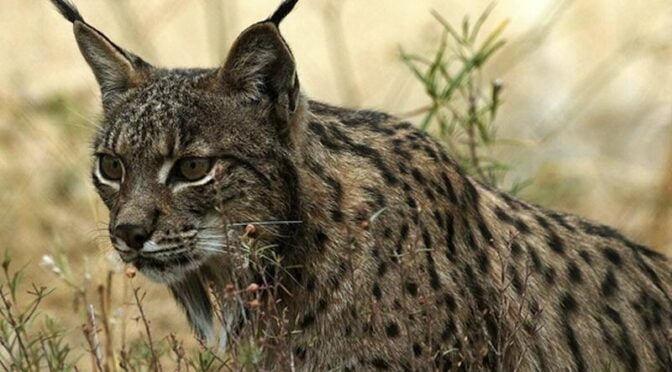Recently, three Iberian lynx specimens – Tiko, Torrealvilla, and Tahúlla – were introduced to the region of Murcia as part of the Life Lynxconnect project. This initiative aims to connect existing lynx populations in Spain and create new centers for this endangered species. The regional government of Murcia invested 400,000 euros in this project, which has been in development for years.

- Read about the Iberian Lynx here: https://wildsideholidays.co.uk/iberian-lynx-lynx-pardinus-lince-iberico/
- Join in with the conversation about Iberian Lynx over at the Iberia Nature Forum: https://iberianatureforum.com/forums/topic/how-many-iberian-lynx-are-there-in-iberia/
Acclimatization Phase
The lynx specimens are currently in acclimatization enclosures located in the area surrounding the Puentes reservoir in Lorca. These enclosures were specially designed to prepare the animals for eventual release. The lynx will stay in the enclosures until April, after which they will be released into the high districts of Lorca. The enclosures include a hectare of land, a pond, trellises, and small spaces for animal shelter. Rabbits both inside and outside the enclosure provide supplementary feeding.
Definitive Release
After the acclimatization phase, the lynx specimens will be released into the high districts of Lorca, and their movement will be tracked by a GPS monitoring system. The project members will evaluate any possible risks and take necessary actions to ensure the initiative’s success.
Environmental Legacy
The regional government of Murcia is committed to leaving an environmental legacy for future generations. According to Fernando López Miras, the president of the Community, “the return of the Iberian lynx to the Region of Murcia is the result of years of intense work within the Life project to recover the populations of this species.” The government hopes that this initiative will succeed and contribute to the conservation of the Iberian lynx.
The Life Lynxconnect Project: Conservation of the Iberian Lynx
The Life Lynxconnect project is the fourth initiative approved by the European Commission for the conservation of the Iberian lynx. Its aim is to create a genetically and demographically functional Iberian lynx metapopulation from 2020 to 2025. The success of the Life Iberlince project led to the Region of Murcia joining the task of recovering the lynx on the Iberian Peninsula.
Collaborators
The Life Lynxconnect initiative involves the Spanish and Portuguese administrations, along with four autonomous communities – Andalusia, Castilla-La Mancha, Extremadura, and the Region of Murcia – and environmental NGOs such as Adenex, WWF-Spain, and the CBD-Habitat Foundation. Representatives from the hunting sector, the Artemisam Foundation, private companies like Fotex and Fomecam Terra, and scientific support from the Higher Council for Scientific Research – Doñana Biological Station are also involved.
Budget
The total budget for the Lynxconnect project is 18,754,029 euros, with 60.67 percent contributed by the Life program, a financial instrument of the European Union. The remaining amount is provided by associated and coordinating beneficiaries. At the regional level, one million euros were allocated, with 400,000 euros invested by the regional government.
Conclusion
The Life Lynxconnect project is an ambitious initiative aimed at preserving the Iberian lynx population. With the support of various organizations and a significant budget, the project aims to create a sustainable and functional metapopulation that will help ensure the survival of this endangered species.
Ronda Today
Everything you need to know before you visit Ronda “The city of dreams” in Andalucia. https://www.rondatoday.com/
Wildside Holidays – Spain
Take a trip on the Wildside! Discover the wildlife and nature of Spain, its Natural and National Parks and find the top wildlife, activity and walking holiday companies.
Iberia Nature Forum
Struggling with identifying those bugs and beasties? Why not check out the Iberia nature Forum!
Discover the Iberia Nature Forum – Environment, geography, nature, landscape, climate, culture, history, rural tourism and travel.
I’ve been living in this lovely area of Western Andalucia for the last 20 years or so and dedicate most of my time to the running of English language tourist information websites for the towns of Cádiz, Ronda, Grazalema, the famous or infamous Caminito del Rey, and also Wildside Holidays, which promotes sustainable and eco-friendly businesses running wildlife and walking holidays in Spain. My articles contain affiliate links that will help you reserve a hotel, bus, train or activity in the area. You don’t pay more, but by using them you do support this website. Thankyou!




